This is a question about .45acp, coated (poly?) bullets with crimp-groove.
I loaded up some .45acp using 200gr, RN bullets coated with red poly-coat. The bullets have 2 grooves. The .45 uses a taper crimp, not roll crimp. I stayed within spec which put the top groove of the bullet right below the case mouth.
There was, however, a raised ridge even with the mouth. This, in turn put the case mouth a bit above the actual bullet end (ogive?). So there was a slight raised area with this ridge and case mouth. Make sense so far?
I had a couple of double-feeds and need to check more, but I'm thinking this raised area might be catching the feed ramp so the round doesn't enter the chamber cleanly.
I'm not gonna use the groove and taper-crimp as usual. Can the crimp be above the surface of the bullet without issue? Should I leave the first groove open and cripm at the 2nd groove to possibly facilitate entering the chamber? Should I do something else besides using a different bullet?
These are coated bullets from Bayou Bullets. Thanks!
I loaded up some .45acp using 200gr, RN bullets coated with red poly-coat. The bullets have 2 grooves. The .45 uses a taper crimp, not roll crimp. I stayed within spec which put the top groove of the bullet right below the case mouth.
There was, however, a raised ridge even with the mouth. This, in turn put the case mouth a bit above the actual bullet end (ogive?). So there was a slight raised area with this ridge and case mouth. Make sense so far?
I had a couple of double-feeds and need to check more, but I'm thinking this raised area might be catching the feed ramp so the round doesn't enter the chamber cleanly.
I'm not gonna use the groove and taper-crimp as usual. Can the crimp be above the surface of the bullet without issue? Should I leave the first groove open and cripm at the 2nd groove to possibly facilitate entering the chamber? Should I do something else besides using a different bullet?
These are coated bullets from Bayou Bullets. Thanks!

